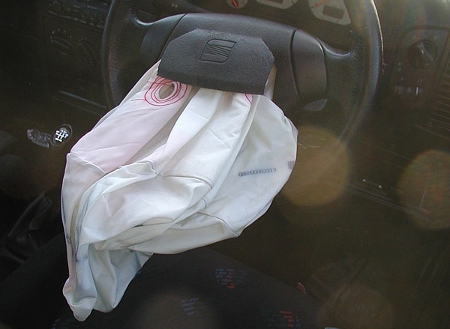Activity: Airbags and Collisions
 (Lesson courtesy Newton’s Apple, a production of Twin Cities Public Television). Level: Students in grades 8 – 12. Time required: 25 – 45 minutes.
(Lesson courtesy Newton’s Apple, a production of Twin Cities Public Television). Level: Students in grades 8 – 12. Time required: 25 – 45 minutes.
Air Bags And Collisions
Overview
In this lesson from Newton’s Apple, students learn about the engineering behind air bags, including the concepts of momentum and force. They then conduct a related experiment, cushioning the “crash” of a raw egg.
Vocabulary
Momentum: The product of the mass and the velocity of an object.
Velocity: Speed in a certain direction (e.g., a car traveling along a straight road with a speed of 70 km/hour also has a velocity of 70 km/hour. A car traveling at 70 km/hour round a bend in a road has a velocity that is continuously changing as the road is not
Force: A push or pull which causes acceleration, or a change in the shape of an object, or a reaction. A force is measured by the change in momentum produced in one second. A force cannot be seen, only its effects can be seen.
Background Information
Moving objects have momentum. Newton’s First Law of Motion says that unless an outside force acts on an object, the object will continue to move at its present speed and direction. Automobiles consist of several objects, including the vehicle itself, the passengers inside and any other loose objects in the vehicle. Unless the objects inside the car are restrained they will continue moving at whatever speed the car is traveling even if the car is stopped by a crash. Changing or stopping an object’s momentum requires a force acting over a period of time. If momentum changes instantly, as in a car crash, the force is very great! If the momentum can be changed over a period of time, even a fraction of a second, much less force needs to be applied with less damage or injury.
Seatbelts: In a head-on collision, if a passenger flies into the dashboard of a car, his or her momentum is instantly stopped, and serious injury is often the result. If the passenger is restrained by a seatbelt, the momentum is reduced more gradually by the constant and smaller force of the belt acting over a longer period of time. Seatbelts can reduce the impact of a passenger to one-fifth of the impact suffered by the body of the car. Passive restraint laws, combined with an interest in air bags have made vehicle safety a selling feature on automobiles.
 Air bags are not intended to replace seat belts. Instead, they are part of a supplemental restraint system. Seat belts are still necessary because air bags only work in front-end collisions of more than 10 miles per hour. Only a seat belt can help in side impacts, rear-end collisions, side swipes and secondary impacts.
Air bags are not intended to replace seat belts. Instead, they are part of a supplemental restraint system. Seat belts are still necessary because air bags only work in front-end collisions of more than 10 miles per hour. Only a seat belt can help in side impacts, rear-end collisions, side swipes and secondary impacts.Questions
- How do airbags prevent automobile injuries?
- How does an air bag resemble a parachute? How is it different?
- Is it possible to invent a springy car that would absorb the impact of accidents by itself?
- Why can’t air bags help when a car is rear ended?
Question extensions
- How does an air bag resemble a parachute? How is it different?
- Is it possible to invent a springy car that would absorb the impact of accidents by itself?
- Why can’t air bags help when a car is rear ended?
ACTIVITY
Materials
- Four-six raw eggs
- Flat bed sheet (twin size works best!)
- Two broom stick handles or dowels
- Needle
- Thread
Procedure
As a joint class activity, and using the concepts they have learned about the use of air bags in automobiles, your students will be challenged to design ways to cushion an egg that is thrown through the air.
Gather and prepare the materials as described below, then explain the procedure to the students, asking them to brainstorm ways to protect the egg from impact. Once they have successfully protected the egg from an initial pitch, have them experiment with different speeds and distances to see how far and fast they can throw the egg without breaking it.
1. Turn under the bottom edge of the sheet about 10 cm. Sew the flap up and insert the broom stick handles into the top cuff and the one you have just sewn.
2. Have four classmates hold the corners of the sheet out horizontally to the ground.
3. Have a fifth student take aim, wind up and pitch the egg up and over onto the sheet.

4. As the students experiment with different speeds and distances, have them write down or verbally discuss the factors that go into the protection of the egg. How does velocity, momentum, and force come into play?
Activity extensions:
Assign students to find other examples of impact protection devices.
- Where are they most common?
- Why do athletes use pads for gymnastics?
- What about helmets and knee pads?
- Do these protection devices transfer momentum?
Teachers can find two additional lessons on airbags, including a chemistry activity, at Science Netlinks.
Watch the accompanying Newton’s Apple video on airbags: http://www.newtonsapple.tv/video.php?id=902
Resources
- Keller, Maryann N. “Better Safe Than Sorry.” Motor Trend, January 1990, p 122.
- Knepper, Mike. “Proper Restraint.” Home Mechanix, September 1989, pp. 72-77.
- Spencer, Peter L. “The Trouble With Air Bags.” Consumers’ Research, January, 1991, pp. 10-13.
Filed under: Class Activities, Grades 6-8, Grades 9-12
Tags: Automotive engineering, Class Activities, design constraints, Egg drop, Ethics in engineering, Grades 6-8, Grades 9-12, Safety engineering








